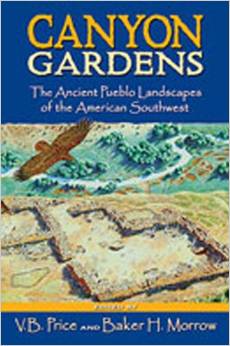 Canyon Gardens brings together the work of investigators from diverse backgrounds to explore the ancient landscape design and horticultural practices of the Pueblo peoples and their relevance to contemporary urban societies. The underlying premise of the work is that the Ancestral Puebloans have a great amount of practical knowledge about how to work and build the land which allowed them to survive, adapt and flourish for over two thousand years. The experience of the Ancestral Puebloans is evidence for the fact that it is possible to “design with nature” and provides us with a model for change as we meet the challenges of the future.
Canyon Gardens brings together the work of investigators from diverse backgrounds to explore the ancient landscape design and horticultural practices of the Pueblo peoples and their relevance to contemporary urban societies. The underlying premise of the work is that the Ancestral Puebloans have a great amount of practical knowledge about how to work and build the land which allowed them to survive, adapt and flourish for over two thousand years. The experience of the Ancestral Puebloans is evidence for the fact that it is possible to “design with nature” and provides us with a model for change as we meet the challenges of the future.
The anthology is divided into two parts. The first considers the ways the ancestral Puebloans lived and adapted to their desert environment over time. It examines landscape features such as pocket terraces, berry gardens, and courtyard suites, and discuses techniques such as site planning, water strategies, and diverse farming tactics including plant use. The final chapter in the anthology deals with how the arrival of the Spanish changed the Pueblo methods of gardening.
The second part of the anthology focuses on the how the practices of the Ancestral Puebloans can influence modern urban societies. By describing the interaction of the various pueblo peoples with “outsiders” including government agencies, it shows the unique sensitivity to the environment of the pueblo culture, and points out the fact that the pueblo people understand sustainability in a way that their modern urban counterparts could use. These lessons should be of interest to professionals, law makers, and anyone interested in the environment.